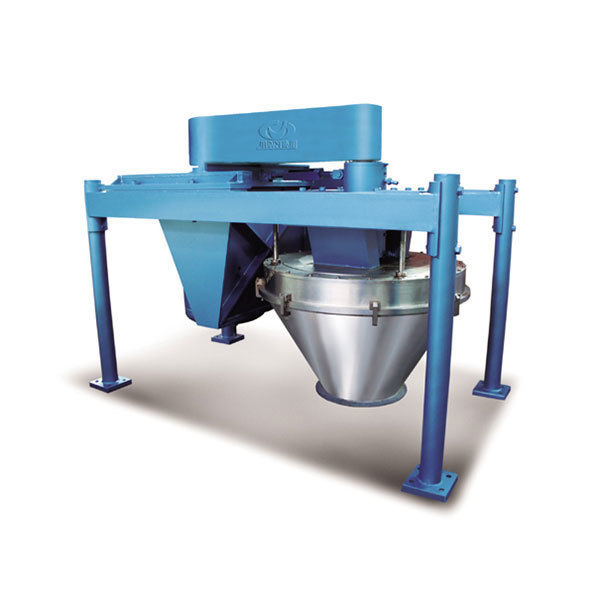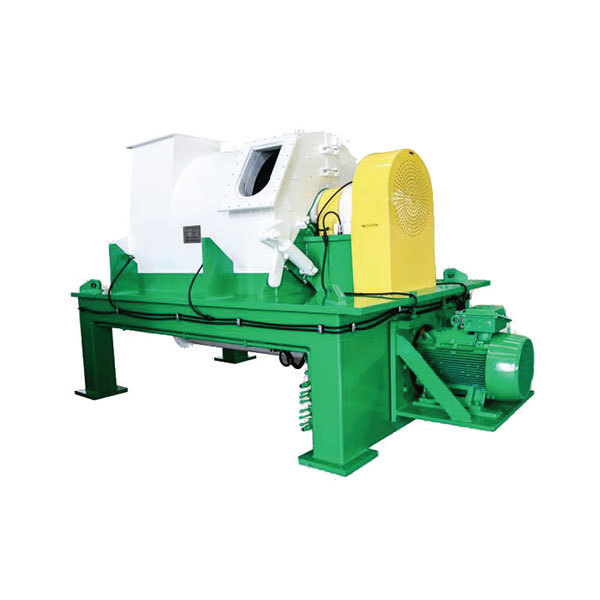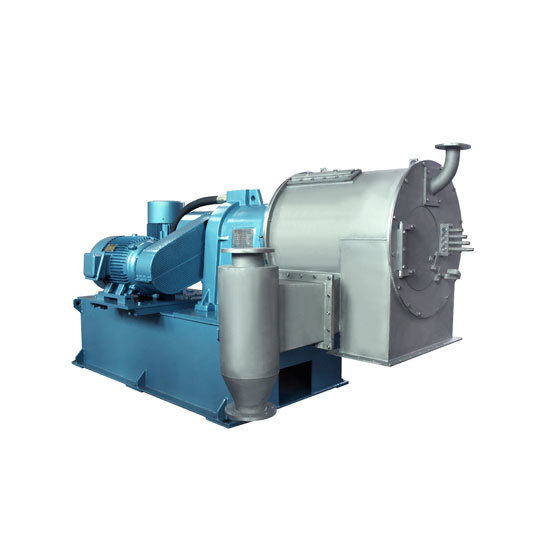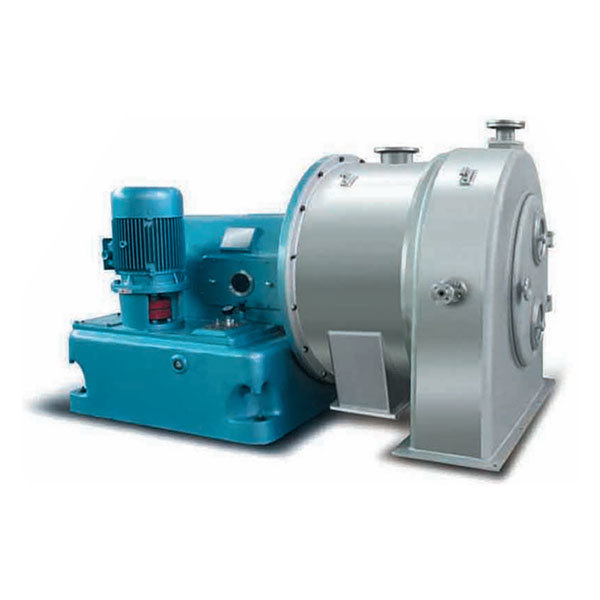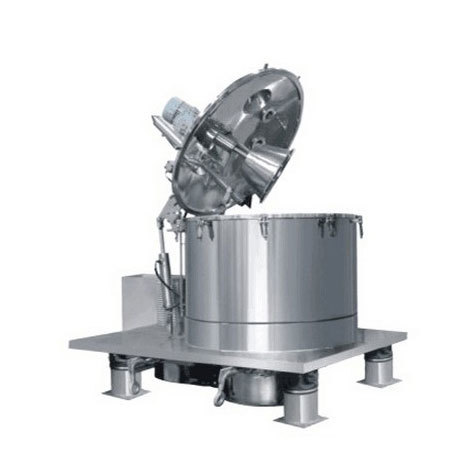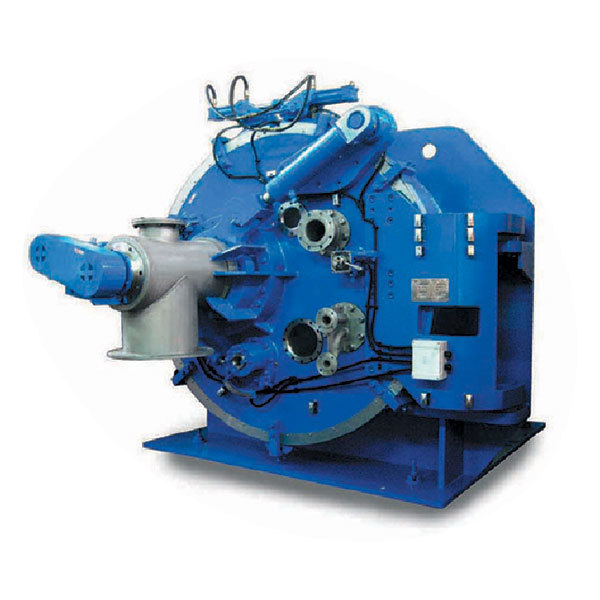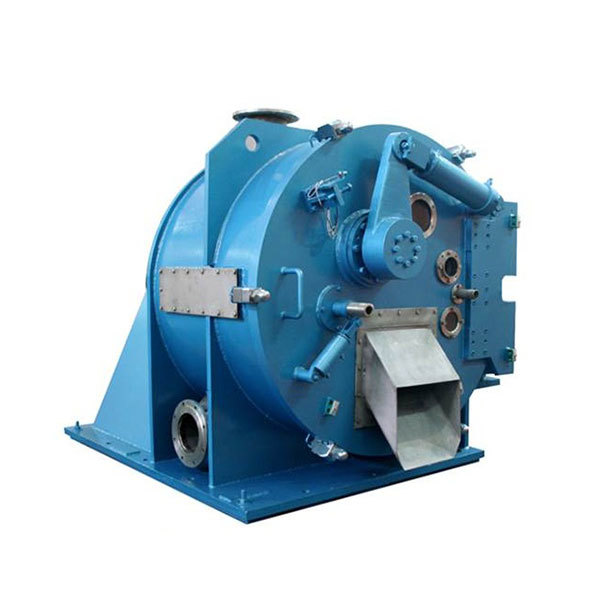HRJ two-stage mechanical pusher centrifuges
Category:
Pusher centrifuges
Detail
HRJ two-stage mechanical pusher centrifuges
Principle of Operation
When the centrifuge is running at full speed, the suspension to be separated is fed through a feed pipe (or feed screw in the case of suspension with higher solid content) into the distributor installed on the outer basket. The suspension is evenly distributed on the screen inside the inner basket under centrifugal force. The liquid phase is discharged through the screen slots and the pores of the basket, while the solid phase is retained on the screen to form a stable filter cake ring. Through the oscillating motion of the inner basket, the filter cake moves forward along the axial direction of the basket and is discharged from the solids discharge channel at end of the outer basket.
Design of products
HRJ two-stage mechanical pusher centrifuges are supported on a base plate through bearing seat assembly and mainly composed of a gearbox, a pusher mechanism, a base plate, bearing seat assembly, baskets, screens, casing and other components. Compared with traditional pusher centrifuges, the model eliminates the hydraulic drive mechanism and adopts a slider-crank mechanism as the drive. The rotating assembly is connected to the rotor motor pulley through V-belts. The electric control box is a separate system, and the electric control cabinet is installed in the electric control room. The on-site operation box is installed in a suitable position near the centrifuge.
Applications
The centrifuge is suitable for separating suspensions containing crystal or short fibrous particles with good filtration properties. The average particle size of the solids is 0.08-3mm, with a concentration (volume ratio) of 30-80%, such as anilino acetonitrile, acrylamide, nickel acetate, acetate fiber, sodium dichromate, soda ash, succinic acid, paraxylene, wastewater salts, ammonium perchlorate, phosphate, sulfate, nitrate, ammonium chloride, potassium chloride, lithium chloride, ferrous chloride, potassium chlorate, chloroacetic acid, cotton seed, gelatin, urea, boric acid, lithium hydroxide, potassium carbonate, ammonium bicarbonate, potassium bicarbonate, urotropine, nitrocellulose, magnesium sulfite, sodium sulfite, sodium nitrite, aluminum oxide, and heavy alkali (secondary dewatering).
HRJ two-stage mechanical pusher centrifuge Standard Sizes and Technical Data
| specification | Basket diameter(mm) | Filter length(mm) | Speed(r/min) | Separation factor(Fr) | Push stroke(mm) | Push frequency(min-1) | Main motor power(kW) | Oil pump motor power(kW) | Capacity (t/h) (under optimal conditions) | Weight of host(kg) | Dimension(mm) |
|---|---|---|---|---|---|---|---|---|---|---|---|
| HRJ280-N | 230/280 | 120/120 | 1800-2800 | 507-1228 | 40 | 30-80 | 5.5-11 | 3 | 0.5-1 (ammonium sulfate) |
2050 | 2210×1460×1095 |
| HRJ400-N | 337/400 | 160/160 | 1400-2300 | 400-1180 | 40 | 30-80 | 7.5-15 | 4 | 2-2.5 (ammonium sulfate) |
2400 | 2530×1290×1155 |
| HRJ500-N | 410/500 | 180/180 | 1200-2000 | 400-1120 | 50 | 50-75 | 37-55 | 15 | 12-18 (salt) |
3800 | 3710×1380×1750 |
A two-stage pusher centrifuge is a highly efficient, continuous solid-liquid separation system widely used in chemical, pharmaceutical, mineral processing, and food production industries. Designed to handle crystalline, granular, or fibrous materials, it delivers exceptional throughput and consistent product quality through a unique two-stage filtration and conveying mechanism. The machine operates horizontally and relies on centrifugal force combined with a reciprocating pusher motion to continuously discharge solids while maintaining stable dewatering performance.
In the first stage, the feed slurry enters the rotating perforated basket, where high-speed centrifugal force rapidly separates the liquid phase from the solid particles. Filtrate passes through the screen, while solids accumulate to form a uniform cake layer. The pusher mechanism then moves the solids forward, enabling continuous advancement without interrupting separation. This design ensures steady processing even with high solid-loading materials, making it ideal for large-scale industrial operations.
The second stage provides enhanced dewatering and washing efficiency. As the compacted cake advances into the next basket section, additional centrifugal force removes residual moisture, while optional wash liquid can be applied to eliminate impurities trapped within the solid structure. This two-level separation and washing process significantly improves purity, making the equipment suitable for demanding applications such as specialty chemicals, polymers, fertilizers, and salt refining.
Key advantages of two-stage pusher centrifuges include high throughput, low residual moisture, and excellent adaptability to a wide range of particle sizes. Their continuous operation minimizes downtime, while robust mechanical design ensures long service life, even under heavy-duty conditions. Energy consumption remains relatively low due to the efficient use of centrifugal force and optimized pusher motion.
Maintenance is simplified through accessible components, reliable sealing systems, and stable vibration control. Advanced models also incorporate monitoring sensors, variable-speed drives, and automated lubrication systems, enabling precise process control and reduced operational cost. With their combination of efficiency, reliability, and versatility, two-stage pusher centrifuges remain a critical piece of equipment for industries requiring continuous, high-performance solid-liquid separation.
Pusher Centrifuge
Previous
Recommended Products
Product Inquiry
Please make sure to fill in the information accurately and keep your communication channels open. We will contact you as soon as possible



